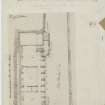Edinburgh, 298-300 Lawnmarket, Old Bank Close, Robert Gourlay's House
House (16th Century) - (19th Century) (1569)-(1839)
Site Name Edinburgh, 298-300 Lawnmarket, Old Bank Close, Robert Gourlay's House
Classification House (16th Century) - (19th Century) (1569)-(1839)
Canmore ID 112242
Site Number NT27SE 659
NGR NT 25597 73558
Datum OSGB36 - NGR
Permalink http://canmore.org.uk/site/112242
- Council Edinburgh, City Of
- Parish Edinburgh (Edinburgh, City Of)
- Former Region Lothian
- Former District City Of Edinburgh
- Former County Midlothian
Demolished 1839? Site of Lothian Regional Council Headquarters.
(Old) Bank Close got the name of Bank Close after 1700, when "the bank" (i.e. the Bank of Scotland, none other being in existence) moved from its burnt-out premises in Parliament Close to a new office in Robert Gourlay's house in the close. It became "the old bank" in 1727, when its rival, "the new bank" or Royal Bank of Scotland appeared on the scene, and thus the address of the Bank of Scotland became "the close of the Old Bank". The Bank quitted the close for its new office in Bank Street in 1806; and the close itself was suppressed in the building of George IV Bridge in about 1830 -its site is now the western pavement at the head of that street. In 1511 it had been known as Mauchan's Close, evidently for Alexander Mauchan, merchant, who is recorded as building two lands, albeit in the Boothraw or Luckenbooths, in that same year. He is also recorded as former owner of the ground on which Robert Gourlay, collector of customs for the burghs, built a house in the close in 1569 -hence the name Gourlay's Close, still used in 1635, when one of two properties then owned by David Gourlay was tenanted by Sir Thomas Hope of Craighall, King's Advocate. Craighall bought it in 1637, giving rise to the further names Hope's Close or Craighall's Close.
(from Stuart Harris, "Place Names of Edinburgh", 1996, pages 77-8).














